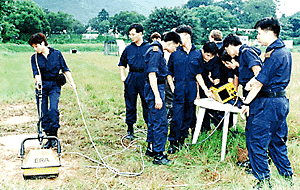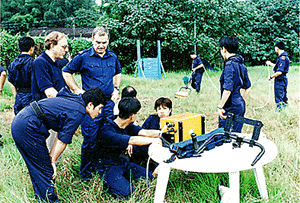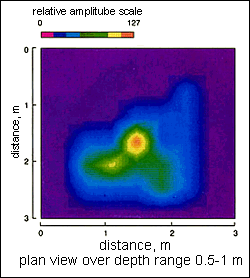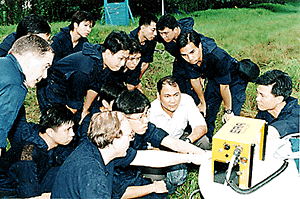



















|
Ground penetrating radar adds new dimension to Force Search Unit | ||
 "Not just for locating buried corpses and murder weapons." Force Search Unit trains on highly sophisticated ground penetrating radar DAVID DANIELS is manager of the radar systems division of ERA Technology (UK), an independent research and technology organisation that, among other things, manufactures components for satellite dishes, TV news gathering equipment and military radar. He has researched many aspects of short-range ultra-wideband radar and is well known for his work in the field of surface/ground penetrating radar. He first became involved with the technique in 1975, using radar as a research tool to measure geological formations. Since then he has pioneered many special applications of surface penetrating radar including its use for forensic archaeology. ¡@The potential for surface penetrating radar as an investigative tool for police was first exploited by UK constabulary during their investigation into the disappearance of the children of Fred and Rosemary West. Ground penetrating radar was used in the search to find their bodies and remains exhumed from unmarked graves in and around the West's Gloucester home, the couple's previous house and adjacent farmland. ¡@The radar equipment was again used by Belgian authorities in similar, deplorable circumstances following the exposure of a much-publicised paedophile ring who murdered then buried their victims. ¡@During both investigations, the advice, expertise and ground penetrating radar equipment of David Daniels was sought and employed by police. ¡@Last week Mr Daniels was in Hong Kong to train a group of officers from the Hong Kong Police Key Points and Search Unit who have recently acquired the surface penetrating radar system for use in Force investigations here. | ||
|
¡@"This will make searching for and finding a corpse or murder weapon buried underground much quicker and easier to find," said CIP George Lee Kiu-ki of the Search Unit. ¡@Even so, the Unit's Superintendent Robin Jolly was quick to point out that this new equipment was not just for locating buried corpses and murder weapons. "It must be emphasised that the ground penetrating radar system's potential as an aid to criminal investigation has yet to be realised," he said. "The only limitation on its use is the imagination." |  Daniels (left) and SP Jolly watch as Search Unit members hone in on buried objects during search exercise | |
|
¡@The range of applications for surface/ground penetrating radar is considerable. Everything from divining the presence of pipes and drains to finding buried treasure to determining the internal structure of buried materials or detecting concealed objects such as a gun, knife, chopper or pipe used in the commission of a crime and buried in a garden. It can locate stashes of heroin hid underground or in a wall or barrier. It can locate reinforcing bars and mats in concrete, or detect concealed explosive mines, buried ordnance, contaminated waste, concealed tunnels and caches of arms and explosives including plastique. ¡@"Surface penetrating radar is an ideal technology where it is essential to operate a in non-destructive mode such as in security searches on walls and other structures of buildings used for, say, meetings of foreign dignitaries - like the finance ministers meeting in Hong Kong at the World Bank annual conference," said Mr Daniels. "It can be used on a wide variety of materials and minimal training is required for use in most situations." ¡@Surface penetrating radar is particularly useful during security searches because it is rapid and provides immediate on-site information on metallic or non-metallic targets. ¡@Technical specifications are complicated but basically the device operates on an electrical pulse system as an effective electromagnetic echo sounder. By moving the radar across a surface an image or "picture" is created in a similar fashion to an ultrasound scan. The pictures are then interpreted by the operator on a computerised monitoring system which uses "Windows" software. The more experienced the operator is in identifying the scanned images - the better the result of the search. | ||
 Radar wave patterns show the remains of a buried animal, in this case a dog |
¡@Different types of ground have different masses affecting the depth of the device's radar penetration - which is 2 metres in commonly occurring ground and materials. In addition to sand, loam, chalk, sandstone, granite - all easy to penetrate - the radar can be used to see through water, snow and concrete walls. ¡@The Hong Kong Police Search Unit is a highly trained and professional cadre of officers drawn from different formations and made operational when circumstances warrant. After in-depth instruction on the use of the surface penetrating radar system from Mr Daniels, the team members, who have a background or interest in technology and computer science, were ready for training in the field. | |
|
¡@It couldn't have been a worse - or better - day. After a deluge of rain that left the Tai Po area with record flooding the search conditions at Queen's Hill in Fan Ling were deplorable - which is frequently the case when called upon in real life investigations. At one end of the playing field, the pitch was extremely sodden, overgrown and tangled. Searching for a murder weapon, say a revolver or knife buried deep in this terrain with a metal detector would have been like looking for a needle in a haystack. If the gun was a Glock, which is made out of special plastic - it would have been next to impossible. ¡@"The best way to learn how to use this system is to make a test area, take the equipment out in the field for a calibrated site search and have people try out the radar unit there," said Mr Daniels in the pouring rain and stifling humidity. "Seldom are the buried remains of murder victims or murder weapons found in friendly terrain." ¡@For these particular training exercises, sites were prepared beforehand with a number of objects - animal bones, a plastic pipe, clay pot and a big blue plastic barrel placed on its side - buried in specific locations. ¡@After a workable section of terrain is delineated and roped off by the search team, the radar unit (light-weight, compact and unceremoniously resembling a bright yellow lawn mower without wheels), is systematically dragged back and forth in the same direction across the site until the radar waves have swept the entire section and been recorded into the computer and displayed on the monitor. ¡@It is quite fascinating to then view the underground world which until now has remained unseen. ¡@At first, it is tough deciphering the radar waves. Mr Daniels points out to the Search Unit members huddled around the monitor that the operator of the radar must learn to discriminate between the searched for target and other natural and unnatural materials like roots or garbage found underground. Much of the skill of the successful user comes from forming a conclusion from both the radar image and a knowledge of the structure of the host material and the characteristics of the target. Over time, an experienced searcher begins to accumulate a catalogue of radar wave shapes of specific targets in his mind which will correspond or not to patterns appearing on the monitor. ¡@An experienced user like David Daniels can recognise different patterns of radar waves to such a degree that he can point out exactly where a buried dog's chest cavity is located. "As it decomposes," he tells the Search Unit members, "the bones break down inwardly and the radar waves capture this procedure via the shadows and displacement of the earth and material around it." ¡@It is obvious from Search Unit members' comments while working with the surface penetrating radar that they are impressed with the device's capabilities and express confidence that it will add to the thoroughness and success of their operations. ¡@Says CIP James Yu Fat-sum: "Learning to accurately interpret the radar images is the most challenging part of operating this equipment. But the more training and field work we experience the more skilled we will become." | ||
|
¡@Commenting on the radar system itself, SP Robin Jolly added: "This is a very sophisticated device and will no doubt become an essential working tool in many of the Search Unit's operations and the Force's criminal investigations." ¡@Echoing SP Jolly's remark, David Daniels added that he was very impressed by the officers of the Search Unit. "They are very attentive and quick to learn. I recommend that they get a lot of practice now so that they will quickly gain the radar wave interpretation skills needed before they are put on the spot by a real search - which of course will happen. I wish them good hunting!" |
 "This is a very sophisticated device . . . and will become an essential tool in many of the Search Unit's operations and the Force's criminal investigations" | |

